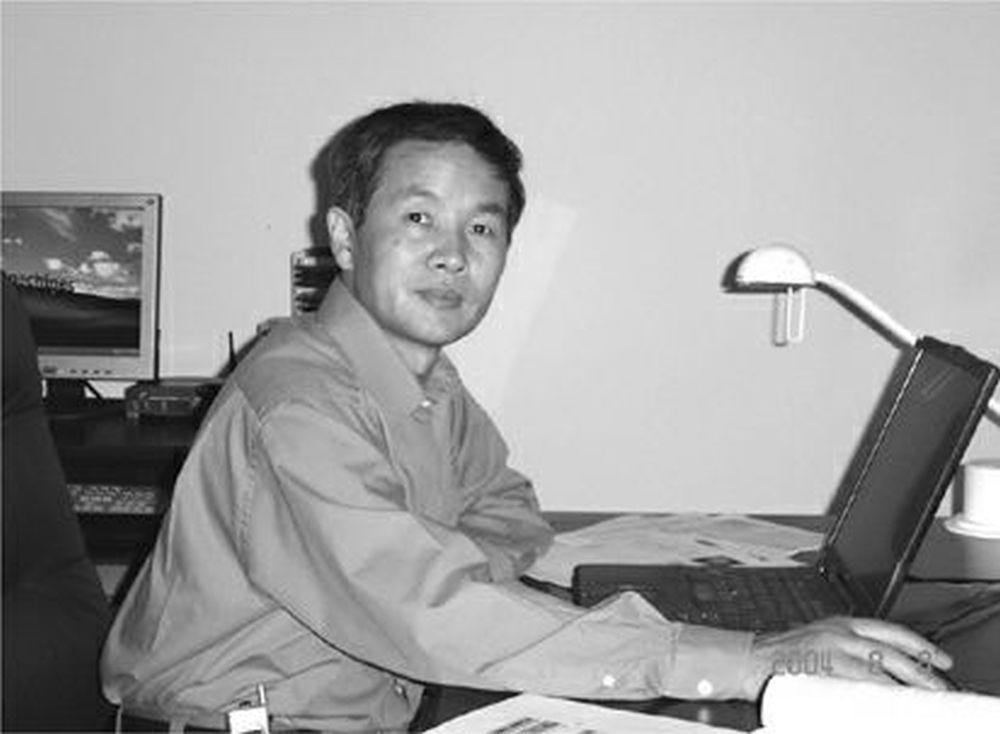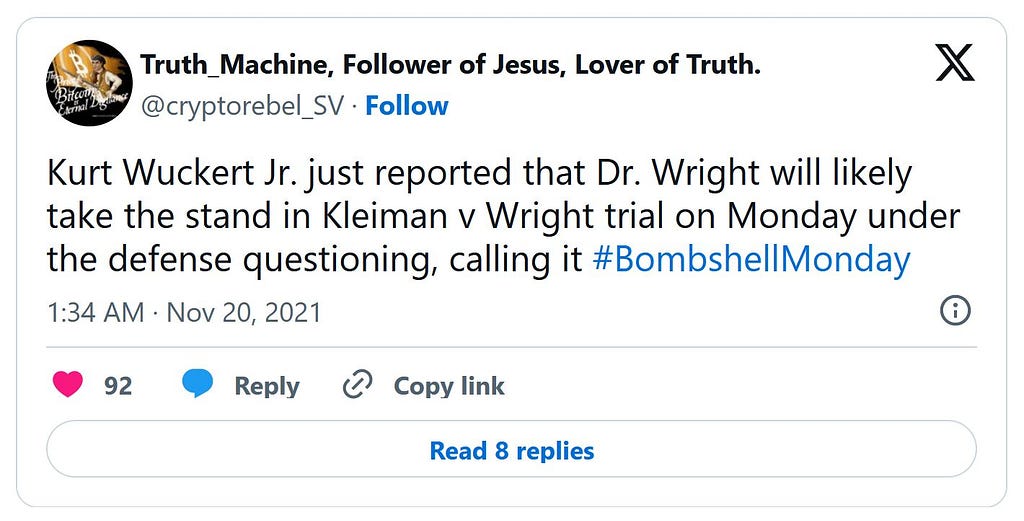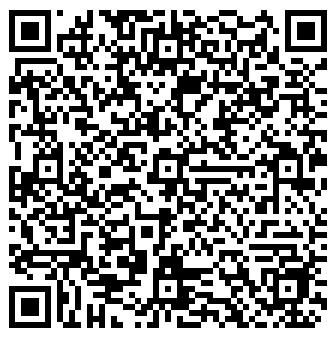Blogs & Articles: Craig Wright: The Wei Dai Lies 🔗 15 weeks ago

- Category: Blogs & Articles | MyLegacyKit on Medium
- Author(s): MyLegacyKit
- Published: 12th January 2024 11:20
And again, our cosplaying con man just can’t keep a Bitcoin origin story straight.
 Someone named Wei Dai. Source: steemkr.com and Blockwhat?
Someone named Wei Dai. Source: steemkr.com and Blockwhat?
“Please note that as of this writing, any purported photos of me on the Internet are actually of other people named Wei Dai.” — Wei Dai on Wei Dai’s Home Page
Written by Arthur van Pelt
ABOUT EDITS AND UPDATES to this article: as more material may become available after the publication of this article, it could have edits and updates every now and then. In that sense, this article can be considered a work in progress, to become a reference piece for years to come.
Intro
Let’s have a quick look at the, pretty limited, email exchanges between Satoshi Nakamoto and cypherpunk Wei Dai that we know about. And then we dive into what Craig Wright ‘remembers’ of his contacts with Wei Dai.
Wei Dai
August 22, 2008: First email from Satoshi Nakamoto to Wei Dai.
In July or August 2008 Adam Back received an email from Satoshi Nakamoto about an “e-cash whitepaper” (the name Bitcoin didn’t exist yet).
Adam suggested Satoshi should look into b-money, which Satoshi didn’t seem to know about yet at that time.
On August 22, 2008 Satoshi contacted Wei Dai for the first time about b-money as he wanted to cite b-money in his e-cash whitepaper.
From: "Satoshi Nakamoto" <satoshi@anonymousspeech.com>
Sent: Friday, August 22, 2008 4:38 PM
To: "Wei Dai" <weidai@ibiblio.org>
Cc: "Satoshi Nakamoto" <satoshi@anonymousspeech.com>
Subject: Citation of your b-money page
I was very interested to read your b-money page. I'm getting ready to
release a paper that expands on your ideas into a complete working system.
Adam Back (hashcash.org) noticed the similarities and pointed me to your
site.
I need to find out the year of publication of your b-money page for the
citation in my paper. It'll look like:
[1] W. Dai, "b-money," https://www.weidai.com/bmoney.txt, (2006?).
You can download a pre-release draft at
https://www.upload.ae/file/6157/ecash-pdf.html Feel free to forward it to
anyone else you think would be interested.
Title: Electronic Cash Without a Trusted Third Party
Abstract: A purely peer-to-peer version of electronic cash would allow
online payments to be sent directly from one party to another without the
burdens of going through a financial institution. Digital signatures
offer part of the solution, but the main benefits are lost if a trusted
party is still required to prevent double-spending. We propose a solution
to the double-spending problem using a peer-to-peer network. The network
timestamps transactions by hashing them into an ongoing chain of
hash-based proof-of-work, forming a record that cannot be changed without
redoing the proof-of-work. The longest chain not only serves as proof of
the sequence of events witnessed, but proof that it came from the largest
pool of CPU power. As long as honest nodes control the most CPU power on
the network, they can generate the longest chain and outpace any
attackers. The network itself requires minimal structure. Messages are
broadcasted on a best effort basis, and nodes can leave and rejoin the
network at will, accepting the longest proof-of-work chain as proof of
what happened while they were gone.
Satoshi
Wei Dai’s reply:
Hi Satoshi. b-money was announced on the cypherpunks mailing list in 1998.
Here's the archived post:
https://cypherpunks.venona.com/date/1998/11/msg00941.html
There are some discussions of it at
https://cypherpunks.venona.com/date/1998/12/msg00194.html.
Thanks for letting me know about your paper. I'll take a look at it and let
you know if I have any comments or questions.
January 10, 2009: There were no comments or questions though, so Satoshi Nakamoto send another, his second and last, email to Wei Dai.
From: Satoshi Nakamoto
Sent: Saturday, January 10, 2009 11:17 AM
To: weidai@weidai.com
Subject: Re: Citation of your b-money page
I wanted to let you know, I just released the full implementation of the
paper I sent you a few months ago, Bitcoin v0.1. Details, download and
screenshots are at www.bitcoin.org
I think it achieves nearly all the goals you set out to solve in your
b-money paper.
The system is entirely decentralized, without any server or trusted
parties. The network infrastructure can support a full range of escrow
transactions and contracts, but for now the focus is on the basics of
money and transactions.
There was a discussion of the design on the Cryptography mailing list.
Hal Finney gave a good high-level overview:
| One thing I might mention is that in many ways bitcoin is two independent
| ideas: a way of solving the kinds of problems James lists here, of
| creating a globally consistent but decentralized database; and then using
| it for a system similar to Wei Dai's b-money (which is referenced in the
| paper) but transaction/coin based rather than account based. Solving the
| global, massively decentralized database problem is arguably the harder
| part, as James emphasizes. The use of proof-of-work as a tool for this
| purpose is a novel idea well worth further review IMO.
Satoshi
More about these emails in this pretty good article by Deniz Tutku on CoinMonks: “Satoshi Nakamoto’s Email to Wei Dai”.
To recap, Satoshi Nakamoto and Wei Dai only exchanged three (3) emails, according the information on Gwern.net. Nothing more, nothing less.
Craig Wright
Now what does Craig Wright “remember” of this era, when he allegedly contacted Wei Dai as Satoshi Nakamoto? On his personal blog Wei Dai is mentioned in an April 16, 2019 article called “Wiki”.
“I dropped off the “Cypherpunks” list and backward economic theory around 2002. Consequently, I didn’t even know about b-money and all the work Wei Dai had done until mid 2008 or so. I referenced Adam Back not because he was the inventor of proof-of-work but for his help at the time. It wasn’t until much later that I even realised that the working version of hashcash came from Hal Finney and that the code Adam Back had put out there didn’t work.
I had emailed other people. In 2007, I had emailed Aurora and a few others. People either couldn’t help me or did not get back to me. Adam Back was well down my list, but he responded.

What I did get from Adam Back was Wei Dai. I didn’t even know of b-money before Adam pointed me to a link. I definitely had no idea about Nick Szabo. Unlike many people I talked to, Wei did not come across as a complete anarchist. Then, I didn’t spend that much time talking to him.
It was Wei I believe who pointed out Szabo’s bit gold boondoggle.
So, I was trying to get people who could help me more, remaining private to some extent. Bitcoin isn’t Adam’s hashcash invention as he puts it. It doesn’t use the code, and is not even similar to what Adam had released. It came from the Aurora paper, for he couldn’t get onto them and they didn’t respond. It was when I was talking to Hal that I discovered he had taken Adam Back’s code and made it work.
So, Wei is referenced as he helped. Adam Back is referenced as he pointed me to Wei.
[…]
Hal [author: Finney] knew much more of Wei and the other attempts post DigiCash than I did.”
Leaving Craig Wright’s attempts to downplay Adam Back aside, and same story for what is undoubtedly a lie about “Aurora and others” (no chance he discussed Bitcoin related things with these people), it appears as if Craig Wright is sticking quite truthfully to the original story of Wei Dai being contacted by Satoshi Nakamoto on his blog.
But then, allow me take some quotes from my article “Craig Wright And The BlackNet Lie”, but originally these statements were outed by Craig Wright on November 22, 2021 during the afternoon session of the Kleiman v Wright trial on that day. The court transcript of this trial day can be found here.
Those who were around at that time to follow the trial closely will remember this day as “BombShell Monday”, as Craig Wright was supposed to reveal a lot of Satoshi evidence. According his fan club, that was.
 Source: FullyCrypto
Source: FullyCrypto
“And Wei Dai, way before this, like in the middle of the year, had sent me code for like some of the cryptographic algorithm, SHA and ECDSA.”
[…]
“One of those [10-page whitepaper drafts] went to Wei Dai. […] There were a couple [of comments] I discussed with Wei Dai. He was more interested in how the code would work. Wei pointed me to a project he had been running called b-money. Wei discussed how b-money was very similar to what I was talking about, but he thought that my project wouldn’t scale. So he thought it would fail.”
[…]
“I had a FTP site on upload.ie in Australia. That was — it hosted it going back till May. So it was technically there, and I pointed people out to the link, like Wei Dai and things, in May.”
 No tweet ever came… Because Craig Wright can’t sign.
No tweet ever came… Because Craig Wright can’t sign.
We immediately notice several discrepancies between the Wei Dai emails and Craig Wright’s memory.
- Wei Dai did not send any code to Satoshi.
- Wei Dai never said that he thought Bitcoin wouldn’t scale and would fail.
- Nothing happened in May 2008 between Satoshi Nakamoto and Wei Dai, it only happened in August 2008 (2 emails) and in January 2009 (1 email).
- No comments were discussed between Satoshi Nakamoto and Wei Dai.
- It wasn’t Wei Dai who pointed Satoshi to b-money, it was Adam Back who pointed Satoshi Nakamoto to Wei Dai’s b-money project.
So I asked Wei Dai what he thinks of these statements of Craig Wright, roleplaying as Satoshi Nakamoto. Wei Dai was very brief, but very clear.
“The entirety of my communications with Satoshi consists of 3 emails, all posted on Gwern’s website.”
Boom. Case closed. One would think. Because the Bitcoin Core Developers used these anecdotes of Wei Dai in their March 2024 Closing Submissions of the COPA v Wright trial (submissions that can be found here in the Trial Documents Dropbox, in the subfolder Skeletons/Closings).
The relevant section of their submissions is copied here in full, as it contains several more debunks related to the Wei Dai lies.
Dr Wright’s Wei Dai lies
On 20 August 2008 Satoshi Nakamoto shared a link to a then draft of the Bitcoin White Paper with Dr Back. He stated as follows:
“I’m getting ready to release a paper that references your Hashcash paper and I wanted to make sure I have the citation right. Here’s what I have:
[5] A. Back, “Hashcash — a denial of service counter-measure,”
https://www.hashcash.org/papers/hashcash.pdf, 2002.
I think you would find it interesting, since it finds a new use for hash-based proof-of-work as a way to make e-cash work. You can download a pre-release draft at https://www.upload.ae/file/6157/ecash-pdf.html
Feel free to forward it to anyone else you think would be interested. I’m also nearly finished with a C++ implementation to release as open source.”
Stopping there, Satoshi was clearly envisaging that Dr Back’s Hashcash paper would be the fifth reference in the Bitcoin White Paper.
Dr Back responded the following day as follows.
“Yes citation looks fine, I’ll take a look at your paper. You maybe aware of the “B-money” proposal, I guess google can find it for you, by Wei Dai which sounds to be somewhat related to your paper. (The b-money idea is just described concisely on his web page, he didnt [sic] write up a paper).”
Two points emerge from that response. First, it was a perfectly friendly reply from Dr Back. Second, and more importantly he drew Satoshi’s reference to the “B-money” proposal made by Wei Dai (which was set out on a web-page, not in a paper).
Satoshi Nakamoto replied to Dr Back on 21 August 2008 as follows:
“Thanks, I wasn’t aware of the b-money page, but my ideas start from exactly that point. I’ll e-mail him to confirm the year of publication so I can credit him. The main thing my system adds is to also use proof-of-work to support a distributed timestamp server. While users are generating proof-of-work to make new coins for themselves, the same proof-of-work is also supporting the network timestamping. This is instead of Usenet.”
Separately, Satoshi wrote to Wei Dai on 22 August 2008 in the following terms:
“I was very interested to read your b-money page. I’m getting ready to release a paper that expands on your ideas into a complete working system. Adam Back (hashcash.org) noticed the similarities and pointed me to your site. I need to find out the year of publication of your b-money page for the citation in my paper. It’ll look like:
[1] W. Dai, “b-money,” https://www.weidai.com/bmoney.txt, (2006?).”
Two points emerge from that email. First, it shows that the prompt for Satoshi Nakamoto’s approach to Wei Dai, was Wei Dai’s b-money page, rather than something else. Second, the effect of inserting a reference to Wei Dai’s b-money page as a first reference to the Bitcoin White Paper, would have been to lead to Dr Back’s paper becoming the sixth reference — as in fact it was in the version published by Satoshi in October 2008. Thus, it is clear that there was no reference in the Bitcoin White Paper to Wei Dai’s b-money page until it was mentioned to Satoshi by Adam Back.
Wei Dai responded to Satoshi Nakamoto at some point afterwards as follows:
“Hi Satoshi. b-money was announced on the cypherpunks mailing list in 1998. Here’s the archived post:
There are some discussions of it at
Thanks for letting me know about your paper. I’ll take a look at it and let
you know if I have any comments or questions.”
There were no further dealings between Satoshi and Wei Dai until the Bitcoin White Paper was published.
Nevertheless, Wright1¶92 {E/1/18} took a wild guess as to what Satoshi’s dealings with Wei Dai might have been, stating:
“Wei Dai was a distinguished academic who had previously proposed a digital currency concept called B-Money, which profoundly impacted my thinking. His work was highly influential and laid the groundwork for some ideas incorporated into the Bitcoin project. Notably, Wei Dai’s contributions were the first that I acknowledged in the White Paper. After I provided him with a copy of the White Paper, he played a significant role in the development process, guiding me to various signature algorithm libraries, including his secure hash algorithm {SHA-256), which I successfully incorporated into the Bitcoin code base.”
Wei Dai was asked by Bird & Bird to comment on that evidence and has confirmed that was not what happened :
“1. I’m not a “distinguished academic” and has actually never worked in academia.
2. My understanding (from Satoshi’s first email to me) is that Satoshi only became aware of b-money when he learned about it from Adam Back, which is after he had completed the draft of the whitepaper that he sent to Adam, so it seems wrong that I profoundly impacted Satoshi’s thinking.
3. I did not play a significant role in the development process of Bitcoin. Specifically I did not guide Satoshi to “various signature algorithm libraries, including his secure hash algorithm (SHA-256)”.
4. You can see the entirety of my communications with Satoshi at
https://gwern.net/doc/bitcoin/2008-nakamoto.”
At Wright11, Dr Wright further tried to suggest that he had been aware of Wei Dai’s b-money proposal prior to his dealings with Dr Back, but was not aware of Wei Dai’s b-money page. That might seem an odd point of detail for Dr Wright to persist with in light of the exchanges with Dr Back and Wei Dai described above. However, Dr Wright was compelled to argue the point because of prior publications by him asserting longstanding familiarity with Wei Dai’s work.
Regrettably that story of longstanding familiarity with Wei Dai is a further pack of lies.
In an article entitled “Fully Peer-to-Peer” published on 6 June 2019, Dr
Wright had referred to enrolling at the University of Newcastle in 2005 as a post-graduate researcher between 2005 and 2009. He stated that entering the university gave him access to the work of Graham Wrightson and Andreas Furche. He went on to say at {L15/88/3}:
“I did not put down that I was Satoshi when I talked to them. I was just another postgraduate researcher and student. … In a conversation that I had when I started my degree with Prof Graham Wrightson, I saw that the separate networks and communication infrastructure would end up merging. … Prof Wrightson knew of Wei Dai, and pointed me towards a paper titled “Knowledge-Based Communication Processes in Building Design” that he knew of because of his work in machine learning. Both Adam Back and Prof Wrightson directed me to Wei Dai. 戴维 turned out to be another cypherpunk, and he was an incredibly helpful one. I used some of his code in the original release of Bitcoin — with his permission. Andreas Furche knew of Hal Finney and Adam Back. So I emailed people. I was researching in 2005, and came to the conclusion that I could build something. By 2007, I was ready to start.”
Every element of that account was imagined:
a) Professor Wrightson had retired from the University of Newcastle on 9
August 2000 and had no further contact with it. He does not recall ever meeting, speaking or working with an individual named Craig Steven Wright and does not know of Wei Dai.
b) Andreas Furche left Newcastle University with Professor Wrightson (and
halfway through his PhD) and completed it at Macquarie. He had never heard of Adam Back.
c) Wei Dai had never written a paper entitled “Knowledge-Based Communication Processes in Building Design”. That seems to be a reference to a paper about the use of CAD systems in the construction
industry written by someone else called Wei Dai from the Commonwealth
Scientific and Industrial Research Organisation in Victoria, Australia.
d) As to the use of code from Wei Dai, Wei Dai has stated {C/28/1}: “I did not directly supply any code to Satoshi. (Again you can see the entirety of my communications with Satoshi at the link I gave earlier.) My understanding is that Satoshi did incorporate some of my code (specifically my implementation of SHA-256) into his Bitcoin code, but that code is in my open source Crypto++ library, and he probably just downloaded and used it
without telling me.”
In short, every aspect of Dr Wright’s story as to his supposed dealings with Professor Wrightson, Andreas Furche and Wei Dai was untrue. When Professor Wrightson’s evidence was drawn to Dr Wright’s attention on Day 6, his response was to say:
“A. I’m sorry if it’s perfectly clear for you, but it’s not. One, I’m not good with remembering people. The funny thing is, when it comes to code, when it comes to other things, I have a near eidetic memory; when it comes to people, I don’t; I don’t even remember faces very well. But when it comes to recalling people, I’m horrible with it. I did have communications with him, I know that they were valuable to me, more than that I can’t say.”
“Q. So your confident assertion in that paper, and the anecdotes about Professor Wrightson pointing you to Wei Dai and discussing Wei Dai with you, that could be wrong?
A. Oh, definitely; I get people wrong all the time. I’ve gone up to people I should know very well and called them the wrong name many times; I do it at work all the time. I have partial aphasia, which means I don’t actually recognise faces properly, so — ”
That is a laughable explanation for his false account of non-existent dealings with Professor Wrightson. Dr Wright has not been able to suggest anyone other than Professor Wrightson who might meet the bill. And far from having an “eidetic” (i.e. photographic) memory of code, Dr Wright could not even recall the CheckBlock function in Bitcoin.
Similarly, confronted with Andreas Furche’s evidence that he had no recollection of Dr Wright, Dr Wright was left on Day 6 suggesting only “I’m pretty sure it was him” (emphasis added):
“Q. Page 1, please {L19/209/1}, an email from Professor Furche. He, too, says that he has no recollection of you, and that he left Newcastle University in 1999. That latter bit is from his witness statement. Do you dispute that he left Newcastle University in 1999?
A. No.
Q. So, he, too, could not have been there to have these rewarding changes with you in 2005 to 2009, could he?
A. Possibly. I was there at that stage. But I was also at the Australian Stock Exchange, where he developed the signal process and some of the software for, and also promoted.
Q. I’ll come to that in a moment. He also says — we can take this document down. He also says in his witness statement that he’s never heard of Hal Finney, with whom — about whom you supposedly had discussions with him. Is he wrong about that?
A. I don’t know. As I said, I’m not good with people, and I could have had it wrong, but I don’t think I am.
Q. He also agrees with Professor Wrightson that the group didn’t have a lot of resources, that it never lodged a patent application and that he doesn’t recognise the patent paper hyperlinked to your article. Do you accept he’s right on those points?
A. Yes. I could have got the wrong person and linked the wrong area. I’m not denying that.
Q. An awful lot of mistakes in your blogpost now, aren’t there?
A. I told you, when it comes to people, I’m terrible. This is the whole thing. When it comes to numbers, code, writing things, a predicate system, I’m great; when it comes to interacting with people … This is why I work from home, this is why I hide away from the world, this is why I don’t interact, why you’re asking me about all these people I’m supposed to remember.
Q. But you do dispute Professor Furche’s claim not to recall you, don’t you?
A. I would find that difficult. I was at the Australian Stock Exchange for a number of years, and the only way I could put it was, I was a gadfly and I was incredibly annoying to a lot of people, including those in seats and other such systems. And some of the other exchanges that he did stuff with as well, I was involved.
Q. {CSW/1/82}, please.
A. Including Chi-X.
Q. Paragraph 433. This is your 11th witness statement, isn’t it, Dr Wright? Yes?
A. Yes.
Q. You claim that Dr Furche and you worked together on the surveillance systems for the Australian Stock Exchange from ’97 to 2003, don’t you?
A. I worked on those systems at that stage, yes, and I believe he was there, and he implemented those —
Q. Professor Furche —
A. — systems at that time.
Q. Professor Furche’s work on the ASX’s surveillance systems didn’t start until after 2003, did it?
A. Well, I still remember him, and I definitely remember im from the Perth Mint.
Q. So you worked together at Perth Mint in 2005 to 2008, yes?
A. No, I was an auditor.
Q. “… then had a joint involvement at the Perth Mint, where I was an auditor for BDO (2005–2008).” Yes?
A. Yes.
Q. In fact, Professor Furche’s work in relation to the Perth Mint didn’t begin until 2016, did it?
A. I don’t know, but I’m pretty sure it was him there, and I believe he was also involved with Chi-X.
Q. Just setting aside the thing you don’t talk about in your 11th witness statement, you couldn’t have had a joint involvement with him at the Perth Mint while you — in 2005 to 2008, because he didn’t have a connection with it at that time, did he?
A. I don’t know, but I do remember him. As I said, I’m terrible with people, but I remember him from something.”
Given the central importance that Dr Wright has attributed to the influence of Wei Dai on the Bitcoin White Paper, the fact that his account of how he came to learn of Wei Dai is riddled with lies is sufficient for the Court to conclude that Dr Wright could not have written the Bitcoin White Paper.
And that is before Dr Wright blundered into suggesting that the Bitcoin White Paper was written in LaTeX.”
That’s it! Thanks for reading.
 Another someone named Wei Dai. Source: med.nyu.edu
Another someone named Wei Dai. Source: med.nyu.edu
Craig Wright: The Wei Dai Lies was originally published in Coinmonks on Medium, where people are continuing the conversation by highlighting and responding to this story.






